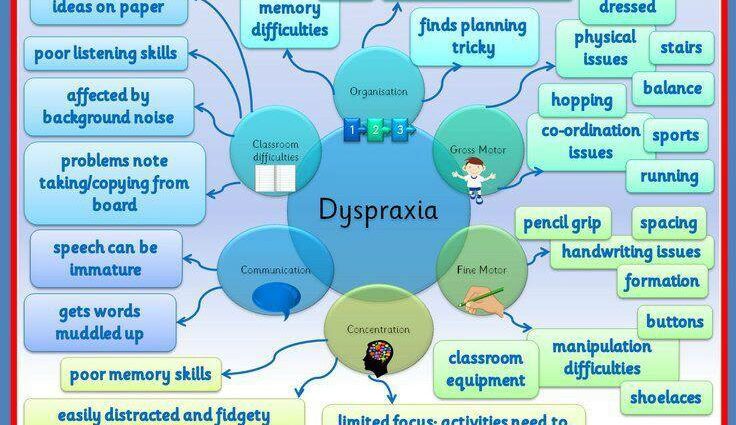Contents
Dyspraxia: definition of this coordination disorder
To put it simply, dyspraxia is a bit to gestures what dyslexia is to words, and dyscalculia to numbers, because it is part of the family of “dys”. We explain to you.
The word dyspraxia comes from the Greek prefix “dys”, Which indicates a difficulty, a malfunction, and the word“praxie”, Which designates a gesture, an action.
Dyspraxia is therefore a cerebral dysfunction that affects praxis, the realization of an intentional gesture, like grabbing an object.
To achieve it, we program this gesture in our head so that it is effective. In people with dyspraxia, this gesture is carried out awkwardly, resulting in failure (a bowl that breaks for example), or success, but difficult to reproduce.
We could, in a way, speak of “pathological clumsiness”. The international denomination speaks more of a disorder of development and coordination.
“Children with dyspraxia have difficulty planning, programming and coordinating complex actions”, Indicates Inserm in an article on the disorders“dys“. “They cannot automate a number of voluntary actions, including writing (which leads to dysgraphia). These children laboriously control the drawing of each letter, which absorbs a large part of their attention and prevents them from paying attention to other aspects (spelling, meaning of words, etc.)”Adds the Research Institute.
But besides this gestural dyspraxia, there is also a constructive dyspraxia, or a difficulty in reconstructing a whole from small parts. A visible disorder in particular via puzzles and construction games, but also in 2D on a plan for example. Note that these two types of dyspraxia can quite coexist. Other subtypes of dyspraxia are sometimes mentioned, when the dyspraxia causes dressing problems (dressing dyspraxia), when there is difficulty in making a gesture with a tool (ideational dyspraxia) …
In video: Dyspraxia
What are the numbers for dyspraxia?
Although there are no precise epidemiological studies, health authorities estimate at around 5 to 7% the number of children aged 5 to 11 affected by dyspraxia. This very approximate and poorly substantiated figure results in particular from the difficulty of diagnosis and the different degrees of impairment.
It should also be noted that dyspraxia is often associated with other disorders “dys“, notably dyslexia and dysorthography.
Causes of dyspraxia
The causes of the onset of dyspraxia are not clearly established.
It could be both genetic causes, which would explain in particular the prevalence of disorders “dys”In several members of the same family, and environmental causes, especially in the development of the embryo and the baby. Using MRI, the researchers observed neuronal disorders in certain regions of the brain, or a connection defect or deficit between different areas of the brain, such as sight and language in children with dyslexia. The troubles “dys”Also seem to be more frequent in children born prematurely, although it is not yet clear why.
How to recognize a dyspraxic child?
We recognize a dyspraxic child by his clumsiness “pathological”: Even by making all possible efforts, trying and trying again to achieve the desired gesture, he does not achieve the desired result.
Getting dressed, tying your shoelaces, drawing, writing, using a compass, a ruler or even a toothbrush, putting on the cutlery … are so many gestures that require a lot of effort and that he does not manage to carry out.
A dyspraxic child will also be not very interested in construction gamesand dexterity, and prefer language-related activities (watch a cartoon, listen to a story, invent an imaginary world …).
At school, the child experiences difficulties, in particular in terms of writing, graphics, arithmetic. As we have seen, dyspraxia is often accompanied by other disorders “dys”, Such as dyscalculia, dyslexia or dysorthography.
A dyspraxic child will generally be distinguished by his slowness, since each seemingly innocuous gesture is difficult for him to perform correctly.
Dyspraxia: how to confirm the diagnosis?
Once the child’s difficulties have been identified following the remarks of the family and the teaching staff, it is important to confirm or deny the diagnosis. To do this, the best is to contact associations dealing with dyspraxia in France, such as DFD (Dyspraxia France Dys) or DMF (Dyspraxic But Fantastic). They refer the parents of dyspraxic children to the various specialists to consult, to ask a precise and personalized diagnosis of dyspraxia. Neurologist, neuro-pediatrician, psychomotor therapist and speech therapist are some of the specialists who will undoubtedly need to be consulted.
What is the management of dyspraxia?
Once a precise diagnosis of dyspraxia has been made, the treatment of children’s dyspraxia will be based on the management of each of its symptoms, again with a multidisciplinary team.
The child will thus work the psychomotricity, occupational therapy, speech therapy, but also sometimes orthoptics or posturology. Psychological follow-up can also be adapted to help him cope with the anxiety and guilt he may feel as a result of his dyspraxia.
Note that at school level, a dyspraxic child will not necessarily need to enter a specialized school. On the other hand, a school life assistant (AVS) can be of great help on a daily basis to accompany it.
Depending on the severity of the dyspraxia, it may be appropriate to apply for personalized schooling project (PPS) with the Departmental House for the Disabled (MDPH) in order to adapt the schooling of the dyspraxic child, or to set up a Personalized Support Plan (PAP) carried out through a collaboration between the school doctor, the parents and the teacher. When the dyspraxia is too severe and / or cannot be treated, a computer equipped with graphics and geometry software, for example, can be of great help.
There are also many resources online to help teachers adapt their lessons to children with dyspraxia.
Sources and additional information:
- https://www.inserm.fr/information-en-sante/dossiers-information/troubles-apprentissages
- https://www.cartablefantastique.fr/
- http://www.tousalecole.fr/content/dyspraxie
- http://www.dyspraxies.fr/










